II. More Racist Stereotypes in Classic Animation
Many cartoon fans have made excuses for racist caricatures that were so common among animators of the 1930s & 1940s, but fact is, there were filmgoers registering their sense of injury & pain over this subject from the start. They are not merely "a product of the times" which meant no harm. They are legitimate products of racism -- the exclusion of blacks from the animation industry was racist, the inability to hear what African American critics was saying was racist.
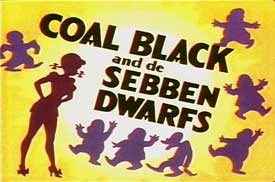 So it didn't take any "new" or "modern" consciousness raising to realize a percentage of the audience was being assaulted by these images. Their children in particular, who loved cartoons as much as children of any race, were especially malligned. So there is no reason to forgive these cartoons. So it didn't take any "new" or "modern" consciousness raising to realize a percentage of the audience was being assaulted by these images. Their children in particular, who loved cartoons as much as children of any race, were especially malligned. So there is no reason to forgive these cartoons.
But I am also against the persisting effectiveness in banning these cartoons. They could appear late-night programming on cable or they could be made more easily available on dvd, but in some cases they are withheld from circulation by the copyright holders, & only pirate copies or poor copies in the public domain are ever seen.
And in a few cases -- darned few, but they're important to note -- the presence of a caricature that really wasn't all that troubling has gotten films of authentic artistic merit banned from television or restricted in distribution. And a cartoon of the quality of Coal Black & de Sebben Dwarves (1942) should never, ever have been banned. Because sometimes a thing can be a veritable compendium of offensive stereotypes & still be art.
This amazing piece of animation ended up on Jerry Beck's list of the fifty greatest cartoons of all time. I would not place it so highly as Beck did -- it wouldn't even be near the bottom of my top one-hundred. It's nevertheless an extraordinary piece of animation. Whether it was viewed for the sheer joy of vintage cartoons or to inspire a serious discussion of hurtful stereotypes, it ought to be as easily accessible as any other classic cartoon.
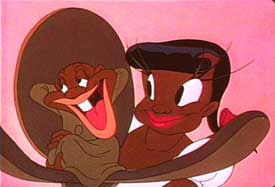 A black mammy is telling her honey chile a fireside story, a jive version of the Snow White story. Right off the bat, then, there's a stereotype of the mammy in bandana, but by no means a hateful stereotype. A black mammy is telling her honey chile a fireside story, a jive version of the Snow White story. Right off the bat, then, there's a stereotype of the mammy in bandana, but by no means a hateful stereotype.
The evil queen of the tale is somewhat more viciously portrayed, a huge white-lipped gap-tooth gin-swilling fat black woman. Sure looks like a my old Aunt Neva on a bender.
She asks the magic mirror to send her a prince, & Prince Chawmin shows up, another black-face white-lipped horror with craps-dice for front teeth. He's not really interested in the queen, but he's interested in that beautiful young gal Snow White (she's not really called Coal Black except in the title).
Snow is a jitterbug beauty who after a touch of blues gives us some jump-jazz while dancing with Chawmin. The queen hires Murder Incorporated to kill her rival, & she's soon kidnapped by thugs. Instead of killing her they dump her in the forest, where she hooks up with a the sebben jive dwarfs, miniature caricatures of black face white lip monstrosities.
She becomes boogie woogie sweetheart of the seben dwarfs until the queen in disguise brings the poison apple & puts Snow into a coma. The dwarfs attack & destroy the witchy queen, & the horrible prince comes to kiss life back into her. But it didn't work. The Dopey among the sebbin dwarfs had to kiss her instead of that Prince Chawmin creep, & Black Dopey was much cuter to be sure.
Should a cartoon like this offend anyone? Of course it should. Should it therefore be banned? Certainly not. Is it a bad cartoon merely because it has racist content? As point of fact it is a rather excellent cartoon.
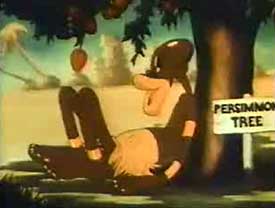 Suppressed for racist caricatures of Africans, Jungle Jitters (1938) features minstrel show style of blacks, black face & enormous white lips, in loin cloths beating jazzy tomtoms.
Suppressed for racist caricatures of Africans, Jungle Jitters (1938) features minstrel show style of blacks, black face & enormous white lips, in loin cloths beating jazzy tomtoms.
There's a slow-motion lazy Stepin Fetchit figure who sloooowly eats a persimmon & whose mouth sloooowly shrinks from the sourness.
They're cannibals with one of those big black iron pots I always wondered how they made if they're such nekkid savages & not a a metalurgist culture.
A door-to-door salesman hick (a clone of Disney's Goofy the dog-man) is trying to sell "useless utensils" for twenty-five cents each, but the cannibals see him only as a plucked & raosted chicken. Next thing you know he's in the cauldron, & the tribe has all his sales stuff to do gags with while waiting for him to cook.
This tribe has a chicken-faced white girl for their queen, a spoof on the white jungle queens of so many films & serials, derived from the Victorian novels of H. Rider Haggard featuring the character of She-Who-Must-Be-Obeyed. And that would mean the bucktooth hick is Allan Quatermain.
When the white queen finds out her followers are having a white man for dinner, she has him removed from the pot & brought to her grass palace, as she is man-hungry but black men won't do. He immediately tries to sell her a novel sort of self-buttering toaster, but she ain't listening.
In her eyes he looks like Clark Gable instead of a dog-faced dufus. She forces him to marry her but when she demands her first kiss, she's so ugly he runs away & jumps back in the cookpot. It's all mildly funny & maximumly offensive.
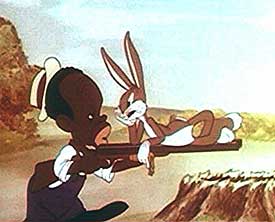 Color cartoon with Bugs Bunny, All This & Rabbit Stew (1941) was long suppressed because Bugs' antagonist is such an exaggeratedly insulting negro caricature, now available on dvd compilations.
Color cartoon with Bugs Bunny, All This & Rabbit Stew (1941) was long suppressed because Bugs' antagonist is such an exaggeratedly insulting negro caricature, now available on dvd compilations.
It's pretty much impossible to guess that the uninteresting title is a play off the Bette Davis film All This & Heaven Too (1940), as the cartoon has absolutely nothing to do with that film.
It was Tex Avery's final Bugs Bunny cartoon, but his name was left off of it because of his left Warner Brothers for Metro-Goldwyn-Mayer & small-minded powers dropped his name. Though one wonders if Avery knew how much it sucked & didn't want his name on it.
The antagonist is a slow-moving slow-talking Stepin Fetchit but a child version, blackface & white lips style derived from whites pretending to be blacks, so resembling no black person you'll ever meet. He slowly, slowly, slowly says "Goh nuh ketch me a raaa bit" dragging his rifle on the ground.
His role is basically the same as Elmer Fudd's & his clueless retarded behavior is probably no worse than Elmer's. In fact the biggest gag of the film, with the black hunter running through a hollow log into mid air, is recast with Elmer Fudd in The Big Snooze (1946). But by making the young black hunter such a gross stereotype he comes off as an attempt to be "funny" by showing niggers are ignorant.
The only gag that really "required" the antagonist to be a black stereotype is when Bugs tricks him in a game of craps at the very end, winning his clothes & rifle leaving the guy naked as Adam.
It's just about unwatchable as it goes through several of Bugs' standard gags with absolutely nothing new involved except the racism.
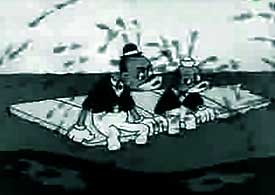 Van Beuren animation studio made low-budget cartoons including of two characters named Tom & Jerry -- not the cat & mouse, but just two regular guys who get in scrapes.
Van Beuren animation studio made low-budget cartoons including of two characters named Tom & Jerry -- not the cat & mouse, but just two regular guys who get in scrapes.
In Plane Dumb (1932) they're in their small private plane flying to Africa. To be safe, they "disguise" themselves in blackface, & the racist antics are just beginning, as looking like black caricatures makes them act like it & talk like it.
They spend rather a lot of time in the sea where they crash-landed, harrassed by octopus, sharks, whale, & doing their Amos & Andy routine.
Finally they come to ground in Africa, encountering totally bizarre fantasy animals. They take refuge in a spooky haunted cave & do "frightened darkies" shtick.
Blackface skeletons sing a Jesus hymn & they flee the cave, pursued by a tribe of nekkid savages with bones through their hair. Please note that there were plenty of complaints about this kind of caricature long before the 1930s rolled around, but honkies just didn't care.
Van Beuren tended to be highly derivative & were especially influenced by Fleischer Studios. Plane Dumb appears to be at least partially in emulation of an even more offensive Fleischer cartoon, I'll Be Glad When You're Dead You Rascal You (1932).
It was also important for the second-rate Van Beuren studios to recycle all bad ideas more than once. So the characters of Tom & Jerry also have close scrapes with the same thick-lip cannibals in Jungle Jam (1931). Before that, a tribe of cannibals threatened Waffles the Cat & Don the Dog while on safari, in Jungle Jazz (1930).
And in the Van Beuren production of Pickaninny Blue (1932), we have a satire on Uncle Tom's Cabin with Topsy as a monkey, Little Eva as a hippopotamus, & the chained slave Uncle Tom who risks his own life to save the hippo's life so they can sing "Dixie" together.
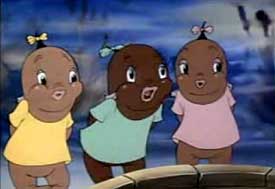 An MGM technicolor cartoon, Swing Social (1940) opens on a rural scene to the tune of "Swing Low Sweet Chariot."
An MGM technicolor cartoon, Swing Social (1940) opens on a rural scene to the tune of "Swing Low Sweet Chariot."
The deacon sees that Brother Brown (lazy Stepin Fetchit clone) is fishing instead of heading off to the community meetin'. He warns Brother Brown that the black bass don't bites on Saturday morning because they have their own Black Bass Social at this time of the week.
The "camera's eye" pans to the bottom of the creek, & the fish, drawn more or less as the same blackface grotesques as the humans above, are jive-dancing.
A black bass who sounds bewilderingly like Randy Newman, sings: "It's the black bass social, a gala affair/ The best folks meetin' from everywhere..."
The big "Social Saturday Morn" number that unfolds has many jazz references & jitterbug beat, & some of it's damned cute despite all.
Sister Creole Dodger is the chef among the black bass. In her kitchen, with chef hat, she sings a number about vitamin enriched viddles & "Plain Fried Chicken." Coulda been worse.
An Ellingtonesque jungle beat results in a jazz tune about voodoo, with a trio of little girls singing boogie woogie harmony while grampa beats that drum. In reply to the voodoo song, the whole social gathering sings "Don't Run from the Devil (Make the Devil Run From You"). In this film's defense, it has pretty good tunes throughout.
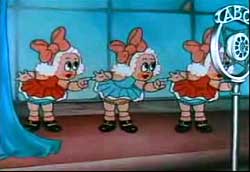 Another two-strip technicolor "Happy Harmonies" MGM cartoon is Toyland Broadcast (1934). It is just so imaginative, set in one of those recurring "toylands" wherein toys have sprung to life.
Another two-strip technicolor "Happy Harmonies" MGM cartoon is Toyland Broadcast (1934). It is just so imaginative, set in one of those recurring "toylands" wherein toys have sprung to life.
In this unusual case, the toys are putting on a radio variety show of jazz & swing, & musically appealing..
This lovely cartoon has suffered recurring edits of censorship reducing its original eight minute length to six minutes, because some of the jazz-performing toys have been regarded as offensive race caricatures.
In this case, however, it is quite possibly a case of overzealous desire to be inoffensive, as the offending moments do not inform the entire film.
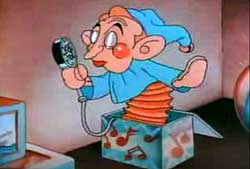 The first act is "The Doll Sisters" who three cupie dolls caricaturing the Brox Sisters family harmony trio. Their song introduces a Bing Crosby jack-in-the-box with enormous ears & stringbean nose, about as ugly a white guy as they could make him. The first act is "The Doll Sisters" who three cupie dolls caricaturing the Brox Sisters family harmony trio. Their song introduces a Bing Crosby jack-in-the-box with enormous ears & stringbean nose, about as ugly a white guy as they could make him.
A tiny doll is shown blowing up a balloon. When the air in the balloon reverses, the doll is blown up into a fat woman, Kate Smith singing "When the Moon Comes Over the Mountain."
Then comes the offending sequence often deleted. Paul Whiteman is shown as a rollypolly doll leading his orchastra, the wind-up "Sambo Jazz Band."
It's actually cute as hell & the individual musicians not horridly caricatured; they're not portrayed as little black sambos at all, but just as black musicians. If such a vintage wind-up toy existed, some black intellectual would probably pay a fortune for one in working order to keep on his coffee table.
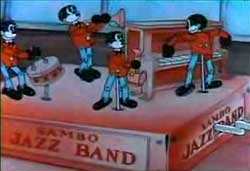 Joining with the Whiteman band is a doll made of wooden beads that dances on a toy xylophone & other toys equally without race reference. Joining with the Whiteman band is a doll made of wooden beads that dances on a toy xylophone & other toys equally without race reference.
A pair of small "French Dolls," boy & girl, do the violent "apache dance" back & forth along piano keys. In such dances the girl is tossed to the floor & treated violently, but in this version, she gets annoyed & fights back & wins.
"Rubinoff & His Violin" are the next act, the violin having feet & arms & striding up to the longhair musician, then dancing back & forth along the bow.
As Rubinoff plays on his dancing violin, a stuffed-animal puppy howls a song, & three stuffed kittens do the "wa wa wa" bits in the Brox Sisters manner, redundant to the opening cupie doll act.
The next often-deleted bit shows golliwogs dancing to jungle music. Then four white porter dolls put on black face (or get choclate syrup spilled on their heads) then do a harmony group vocal.
The song begins "Dusky maiden/ Dark-eyed siren/ Congo sweetheart/ I'm coming back for you." It's actually quite a nice song, called "Jungle Fever," about love in the Congo.
It's usually the Mills Brothers who get spoofed in cartoons like like this one, but in this case they more closely resemble The Jones Boys or The Cats & the Fiddle or the Delta Rhythm Boys.
While they're singing, numerous stuffed animals dance, then a chubby Aunt Jemima type figure dances center stage & sings a bit like Ethel Waters. But Ethel was really glamorous in the 1930s & I can't quite see how they got Aunt Jemima out of her.
Some cartoons can reasonably be said to be inappropriate for children who should not have old racist images imprinted on their young mans to be perpetuated through another generation, but Toyland Broadcast is in the main "politically incorrect" rather than validly offending. Only the golliwogs are abominable, & this is otherwise brilliant cartoon really deserves to be shown intact & uncensored.
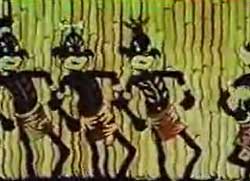 A Merry Melodies cartoon The Isle of Pingo Pongo (1938) was suppressed for insensitive caricatures. The ocean liner U.S.S. Minnie (after Minnie the Moocher?) sets out for the vacation island.
A Merry Melodies cartoon The Isle of Pingo Pongo (1938) was suppressed for insensitive caricatures. The ocean liner U.S.S. Minnie (after Minnie the Moocher?) sets out for the vacation island.
Half its length is devoted to punning sight-gags about islands & wildlife, some quite funny, & a recurring figure with violin case asking periodically "Is it time yet boss?" but the narrator keeps telling him, "No, not yet." As a coda the narrator will tell him it's time for a final rather poor gag.
The second half is devoted to caricatures of an African tribe. Why they're African rather than Polynesian, who knows. They are standard big-lips bone-through-hair simian caricatures of the worst kind.
We first see a group of these awful figures beating tomtoms then bursting into a minstrel-show rendition of "She'll Be Coming 'Round the Mountain When She Comes." Curiously they sound much more like white hillbillies than a black harmony group.
There follows image upon image that seems to have no point beyond offense. Few if any of these gags seem likely to have been funny even if you didn't care that it was so racist.
Toward the end we get a second musical number which is a harmony group arrangement of "Sweet Georgia Brown" with a midget Fats Waller added to the usual group of four. Though no less offending than the rest, it's at least a pleasant musical sound.
The big finale is a Cotton Club style floor show with chorus girls & big band, one fellow's giant lips turning into a coronet.
copyright © by Paghat the Ratgirl
|
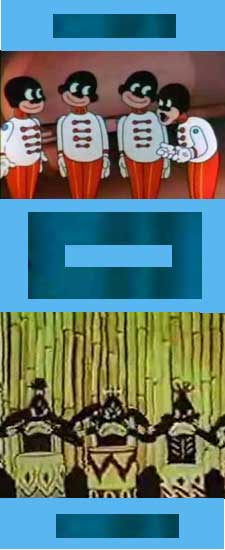
 So it didn't take any "new" or "modern" consciousness raising to realize a percentage of the audience was being assaulted by these images. Their children in particular, who loved cartoons as much as children of any race, were especially malligned. So there is no reason to forgive these cartoons.
So it didn't take any "new" or "modern" consciousness raising to realize a percentage of the audience was being assaulted by these images. Their children in particular, who loved cartoons as much as children of any race, were especially malligned. So there is no reason to forgive these cartoons. A black mammy is telling her honey chile a fireside story, a jive version of the Snow White story. Right off the bat, then, there's a stereotype of the mammy in bandana, but by no means a hateful stereotype.
A black mammy is telling her honey chile a fireside story, a jive version of the Snow White story. Right off the bat, then, there's a stereotype of the mammy in bandana, but by no means a hateful stereotype.




 The first act is "The Doll Sisters" who three cupie dolls caricaturing the Brox Sisters family harmony trio. Their song introduces a Bing Crosby jack-in-the-box with enormous ears & stringbean nose, about as ugly a white guy as they could make him.
The first act is "The Doll Sisters" who three cupie dolls caricaturing the Brox Sisters family harmony trio. Their song introduces a Bing Crosby jack-in-the-box with enormous ears & stringbean nose, about as ugly a white guy as they could make him. Joining with the Whiteman band is a doll made of wooden beads that dances on a toy xylophone & other toys equally without race reference.
Joining with the Whiteman band is a doll made of wooden beads that dances on a toy xylophone & other toys equally without race reference.